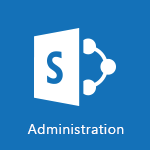SharePoint (Classic Sites) - Creating a personalized permission level Video
In this video, you will learn about creating a personalized permission level in SharePoint.
The video covers how to control who can edit your site and how to assign permissions to groups of users.
This will help you customize the permissions for different teams or departments in your organization.
By following the steps outlined in the video, you will be able to create a new permission level with specific actions and permissions tailored to your needs.
This personalized permission level can then be assigned to the relevant groups in SharePoint.
- 2:46
- 2905 views
-
SharePoint (Classic Sites) - Creating a personalized permission level
- 2:46
- Viewed 2905 times
-
SharePoint (Classic Sites) - Restoring an earlier version of your document
- 1:50
- Viewed 3035 times
-
SharePoint (Classic Sites) - Recovering deleted items (Recycle bin and Second-stage recycle bin)
- 2:18
- Viewed 4848 times
-
SharePoint (Classic Sites) - Targeting content using a specific audience
- 3:35
- Viewed 2920 times
-
SharePoint (Classic Sites) - Sharing a folder or document with someone outside the company
- 3:44
- Viewed 2903 times
-
SharePoint (Classic Sites) - Restricting a document to read-only mode (Extract a document)
- 2:05
- Viewed 2821 times
-
SharePoint (Classic Sites) - Checking the granted shares
- 2:27
- Viewed 2852 times
-
SharePoint (Classic Sites) - Granting access to the SharePoint site to someone outside the company
- 3:46
- Viewed 3198 times
-
Protect a document shared by password
- 1:41
- Viewed 9552 times
-
How do I prevent the transfer of an email?
- 2:07
- Viewed 8599 times
-
Recovering deleted items (Recycle bin and Second-stage recycle bin)
- 2:18
- Viewed 4848 times
-
How do I block a sender?
- 1:01
- Viewed 3784 times
-
How do I share a document securely with Outlook?
- 1:49
- Viewed 3527 times
-
Create and manage team channel
- 1:51
- Viewed 3383 times
-
Do I share with OneDrive, SharePoint, or TEAMS?
- 2:24
- Viewed 3328 times
-
Manage permissions
- 1:10
- Viewed 3240 times
-
Restrict a folder/document to certain members of your team
- 1:49
- Viewed 3219 times
-
Restrict a document to reading only
- 1:03
- Viewed 3203 times
-
Granting access to the SharePoint site to someone outside the company
- 3:46
- Viewed 3198 times
-
How do I recognize a fraudulent email?
- 2:01
- Viewed 3040 times
-
Restoring an earlier version of your document
- 1:50
- Viewed 3035 times
-
Targeting content using a specific audience
- 3:35
- Viewed 2920 times
-
Sharing a folder or document with someone outside the company
- 3:44
- Viewed 2903 times
-
Understanding the different types and roles of team sites in SharePoint
- 3:05
- Viewed 2859 times
-
Checking the granted shares
- 2:27
- Viewed 2852 times
-
Restricting a document to read-only mode (Extract a document)
- 2:05
- Viewed 2821 times
-
How to protect an email by encryption?
- 2:41
- Viewed 2771 times
-
Creating a permission group
- 3:53
- Viewed 2725 times
-
Ensure data security during a Teams meeting
- 1:48
- Viewed 2639 times
-
General security practices in Outlook
- 1:03
- Viewed 2589 times
-
Manage permissions
- 1:03
- Viewed 1634 times
-
Understand and Secure Information Sharing in Instant Messaging
- 2:38
- Viewed 1037 times
-
Manage Privacy in Private Channels
- 2:34
- Viewed 827 times
-
Restrict a Document to Certain Team Members
- 1:50
- Viewed 821 times
-
Secure Teams Upon Creation
- 2:57
- Viewed 801 times
-
Secure a Shared Document with a Password
- 1:28
- Viewed 790 times
-
Restrict a Document to Read-Only
- 0:58
- Viewed 786 times
-
Check Granted Shares
- 00:48
- Viewed 430 times
-
Protect My Document with a Password and Expiration Date
- 01:02
- Viewed 374 times
-
Modify Sharing Rules
- 00:53
- Viewed 372 times
-
Recover deleted items
- 01:09
- Viewed 361 times
-
Best Security Practices on OneDrive
- 01:27
- Viewed 356 times
-
Restore Your OneDrive Space
- 01:42
- Viewed 346 times
-
Avoid Abusive Document Sharing
- 00:57
- Viewed 332 times
-
Block a sender
- 01:54
- Viewed 280 times
-
Recall or replace an e-mail message
- 01:45
- Viewed 243 times
-
Prevent transfer for a meeting
- 01:19
- Viewed 213 times
-
Prevent the forwarding of an email
- 01:01
- Viewed 212 times
-
Share a document securely with Outlook
- 02:21
- Viewed 207 times
-
Identify a fraudulent email
- 02:06
- Viewed 206 times
-
Protect an email by encrypting
- 01:10
- Viewed 205 times
-
Guide to Using the Microsoft Authenticator App
- 01:47
- Viewed 186 times
-
Provide an overview of best security practices in Outlook
- 01:08
- Viewed 178 times
-
Concept of Multi-Factor Authentication
- 01:51
- Viewed 173 times
-
Turn on Multi-Factor Authentication in the Admin Section
- 02:07
- Viewed 146 times
-
Introduction to PowerBI
- 00:60
- Viewed 167 times
-
Introduction to Microsoft Outlook
- 01:09
- Viewed 158 times
-
Introduction to Microsoft Insights
- 02:04
- Viewed 155 times
-
Introduction to Microsoft Viva
- 01:22
- Viewed 161 times
-
Introduction to Planner
- 00:56
- Viewed 169 times
-
Introduction to Microsoft Visio
- 02:07
- Viewed 158 times
-
Introduction to Microsoft Forms
- 00:52
- Viewed 164 times
-
Introducing to Microsoft Designer
- 00:28
- Viewed 224 times
-
Introduction to Sway
- 01:53
- Viewed 142 times
-
Introducing to Word
- 01:00
- Viewed 165 times
-
Introducing to SharePoint Premium
- 00:47
- Viewed 147 times
-
Create a call group
- 01:15
- Viewed 200 times
-
Use call delegation
- 01:07
- Viewed 128 times
-
Assign a delegate for your calls
- 01:08
- Viewed 200 times
-
Ring multiple devices simultaneously
- 01:36
- Viewed 136 times
-
Use the "Do Not Disturb" function for calls
- 01:28
- Viewed 126 times
-
Manage advanced call notifications
- 01:29
- Viewed 141 times
-
Configure audio settings for better sound quality
- 02:08
- Viewed 173 times
-
Block unwanted calls
- 01:24
- Viewed 140 times
-
Disable all call forwarding
- 01:09
- Viewed 141 times
-
Manage a call group in Teams
- 02:01
- Viewed 132 times
-
Update voicemail forwarding settings
- 01:21
- Viewed 130 times
-
Configure call forwarding to internal numbers
- 01:02
- Viewed 123 times
-
Set call forwarding to external numbers
- 01:03
- Viewed 148 times
-
Manage voicemail messages
- 01:55
- Viewed 187 times
-
Access voicemail via mobile and PC
- 02:03
- Viewed 205 times
-
Customize your voicemail greeting
- 02:17
- Viewed 125 times
-
Transfer calls with or without an announcement
- 01:38
- Viewed 121 times
-
Manage simultaneous calls
- 01:52
- Viewed 131 times
-
Support third-party apps during calls
- 01:53
- Viewed 160 times
-
Add participants quickly and securely
- 01:37
- Viewed 132 times
-
Configure call privacy and security settings
- 02:51
- Viewed 130 times
-
Manage calls on hold
- 01:20
- Viewed 137 times
-
Live transcription and generate summaries via AI
- 03:43
- Viewed 126 times
-
Use the interface to make and receive calls
- 01:21
- Viewed 131 times
-
Action Function
- 04:18
- Viewed 139 times
-
Search Function
- 03:42
- Viewed 188 times
-
Date and Time Function
- 02:53
- Viewed 169 times
-
Logical Function
- 03:14
- Viewed 255 times
-
Text Function
- 03:25
- Viewed 200 times
-
Basic Function
- 02:35
- Viewed 158 times
-
Categories of Functions in Power FX
- 01:51
- Viewed 188 times
-
Introduction to Power Fx
- 01:09
- Viewed 159 times
-
The New Calendar
- 03:14
- Viewed 282 times
-
Sections
- 02:34
- Viewed 171 times
-
Customizing Views
- 03:25
- Viewed 166 times
-
Introduction to the New Features of Microsoft Teams
- 00:47
- Viewed 271 times
-
Guide to Using the Microsoft Authenticator App
- 01:47
- Viewed 186 times
-
Turn on Multi-Factor Authentication in the Admin Section
- 02:07
- Viewed 146 times
-
Concept of Multi-Factor Authentication
- 01:51
- Viewed 173 times
-
Retrieve Data from a Web Page and Include it in Excel
- 04:35
- Viewed 392 times
-
Create a Desktop Flow with Power Automate from a Template
- 03:12
- Viewed 334 times
-
Understand the Specifics and Requirements of Desktop Flows
- 02:44
- Viewed 206 times
-
Dropbox: Create a SAS Exchange Between SharePoint and Another Storage Service
- 03:34
- Viewed 349 times
-
Excel: List Files from a Channel in an Excel Workbook with Power Automate
- 04:51
- Viewed 222 times
-
Excel: Link Excel Scripts and Power Automate Flows
- 03:22
- Viewed 228 times
-
SharePoint: Link Microsoft Forms and Lists in a Power Automate Flow
- 04:43
- Viewed 404 times
-
SharePoint: Automate File Movement to an Archive Library
- 05:20
- Viewed 199 times
-
Share Power Automate Flows
- 02:20
- Viewed 193 times
-
Manipulate Dynamic Content with Power FX
- 03:59
- Viewed 197 times
-
Leverage Variables with Power FX in Power Automate
- 03:28
- Viewed 184 times
-
Understand the Concept of Variables and Loops in Power Automate
- 03:55
- Viewed 196 times
-
Add Conditional “Switch” Actions in Power Automate
- 03:58
- Viewed 232 times
-
Add Conditional “IF” Actions in Power Automate
- 03:06
- Viewed 168 times
-
Create an Approval Flow with Power Automate
- 03:10
- Viewed 361 times
-
Create a Scheduled Flow with Power Automate
- 01:29
- Viewed 584 times
-
Create an Instant Flow with Power Automate
- 02:18
- Viewed 338 times
-
Create an Automated Flow with Power Automate
- 03:28
- Viewed 328 times
-
Create a Simple Flow with AI Copilot
- 04:31
- Viewed 306 times
-
Create a Flow Based on a Template with Power Automate
- 03:20
- Viewed 274 times
-
Discover the “Build Space”
- 02:26
- Viewed 192 times
-
The Power Automate Mobile App
- 01:39
- Viewed 200 times
-
Familiarize Yourself with the Different Types of Flows
- 01:37
- Viewed 193 times
-
Understand the Steps to Create a Power Automate Flow
- 01:51
- Viewed 282 times
-
Discover the Power Automate Home Interface
- 02:51
- Viewed 187 times
-
Access Power Automate for the Web
- 01:25
- Viewed 298 times
-
Understand the Benefits of Power Automate
- 01:30
- Viewed 245 times
Objectifs :
This document aims to provide a comprehensive guide on managing permissions in SharePoint, specifically for SharePoint administrators and site collection managers. It outlines how to control editing rights for different user groups, create custom permission levels, and navigate the SharePoint interface effectively.
Chapitres :
-
Introduction to SharePoint Permissions
In SharePoint, managing permissions is crucial for controlling who can edit or view content on your site. For instance, you may want to allow financial service staff to edit lists while restricting the marketing department to view-only access. This document will guide you through the process of setting up and customizing permissions. -
Understanding Permissions
Permissions in SharePoint dictate what actions users can perform, such as editing items in a list or creating new sites. However, you cannot assign individual permissions directly to users. Instead, permissions are grouped under permission levels, which can then be assigned to groups of users. -
Default Permission Levels
SharePoint includes several default permission levels, such as 'Contribute' and 'Read'. If these do not meet your requirements, you have the option to create new permission levels tailored to your needs. -
Creating and Managing Permission Levels
To create or modify permission levels, you must belong to a SharePoint group authorized to manage permissions. Typically, this includes members of the owners group or site collection administrators. Follow these steps to create a new permission level: 1. Navigate to the top-level site in your site collection. 2. Click on the gear icon (⚙️) to access settings. 3. Select 'Site Settings'. 4. In the 'Users and Permissions' section, click on 'Site Permissions'. 5. In the permissions tab, click on 'Permission Levels'. 6. On the Permission Levels page, select 'Add a Permission Level'. 7. Enter a name and description for the new permission level. 8. In the permissions area, activate all checkboxes corresponding to the personal list and site permissions you wish to include. 9. Click 'Create' to finalize your new permission level. -
Conclusion
By following the steps outlined above, you can effectively manage permissions in SharePoint, ensuring that users have the appropriate access levels based on their roles. Customizing permission levels allows for greater flexibility and control over your SharePoint environment.
FAQ :
What are permissions in SharePoint?
Permissions in SharePoint are settings that control what actions users can perform, such as editing lists or creating sites. They help manage access to content and functionalities.
How can I create a new permission level in SharePoint?
To create a new permission level, you need to be part of a SharePoint group authorized to manage permissions. Navigate to Site Settings, select Site Permissions, and then click on Permission Levels to add a new level.
Can I assign individual permissions to users in SharePoint?
No, you cannot assign individual permissions to users in SharePoint. Instead, you group associated permissions under a permission level and assign that level to a group of users.
What is the difference between the 'Contribute' and 'Read' permission levels?
'Contribute' permission allows users to add, edit, and delete items in lists, while 'Read' permission only allows users to view items without making changes.
What should I do if the default permission levels do not meet my needs?
If the default permission levels do not meet your needs, you can create new ones by following the steps to add a permission level in the Site Permissions settings.
Quelques cas d'usages :
Managing Access for Financial Services Staff
In a financial services organization, the SharePoint administrator can create a custom permission level that allows staff to edit lists related to financial data while restricting marketing department members to view-only access. This ensures sensitive information is protected while enabling collaboration among relevant teams.
Customizing Permissions for Project Teams
A project manager can use SharePoint to create a specific permission level for a project team, allowing them to edit project documents and lists while preventing other departments from accessing or modifying these files. This enhances project security and streamlines collaboration.
Setting Up a Knowledge Base
An organization can set up a knowledge base in SharePoint where employees can contribute articles and resources. By creating a custom permission level that allows contributions from specific teams while restricting others to read-only access, the organization can maintain quality control over the content.
Training New Employees
When onboarding new employees, a SharePoint administrator can create a permission level that allows them to access training materials and resources without the ability to edit or delete content. This ensures that new hires have the information they need while maintaining the integrity of the training materials.
Glossaire :
SharePoint
A web-based collaboration platform developed by Microsoft that integrates with Microsoft Office. It is used for storing, organizing, sharing, and accessing information from any device.
Permissions
Settings that determine what actions users can perform in SharePoint, such as editing items in a list or creating a site.
Permission Levels
Groups of associated permissions that can be assigned to users or groups in SharePoint. Examples include 'Contribute' and 'Read'.
Site Collection Administrator
A user who has full control over a site collection in SharePoint, including managing permissions and settings.
Owners Group
A default group in SharePoint that typically has full control over a site, allowing members to manage permissions and settings.
Customization Options
Various settings and configurations available in SharePoint that allow administrators to tailor permissions and functionalities to meet specific needs.




